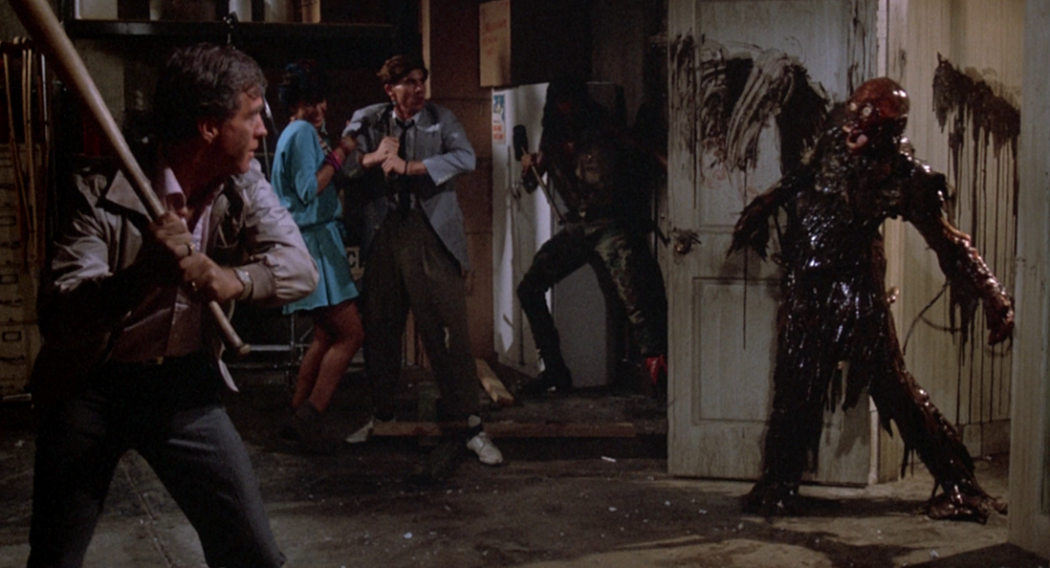Dan O’Bannon’s divergent pseudo-sequel, which screens this Sat at Union South, gets zombies to use their braaaaains
If there’s a common criticism of Danny Boyle’s excellent zombie thriller 28 Days Later, it’s the zombies themselves. Not long after Cillian Murphy’s courier awakes from his coma and wanders the seemingly deserted streets of London, swarms of ravenous infected spring out of the woodwork, their mad dashes fueled by a contagious bloodlust. For acolytes of George A. Romero and his school of the dead, groaning brain-eaters are permitted to stumble after their prey — a tradition that goes back at least as far as Night of the Living Dead (1968) — but running zombies? That’s a no-no. The cardiovascular inclinations of Boyle’s zombies have remained divisive sticking point among horror enthusiasts to this day, but here’s the catch: Dan O’Bannon did it first.
A lot has changed between Romero’s 1968 classic and Return of the Living Dead, O’Bannon’s 1985 pseudo-sequel. Now, zombies are smart. Zombies form coherent sentences. In the case of Linnea Quigley’s ill-fated cemetery striptease, zombies can be sexy. And yes, zombies can run. After a foreman at a medical supply company (James Karen) accidentally releases a mysterious gas, the dead come back to life. First, it’s the facility’s cadavers. Before long though, the nearby cemetery’s pumping out reanimated corpses, using their braaaaains to croak out calls for more EMTs and police officers over emergency radio traffic as the body count quickly piles up. The plasticine faux-punk is already miles away from Romero’s milder counter-cultural elements but even the zombies, the one true commonality between the two, couldn’t feel more different.
Dan O’Bannon, who built up his stock in Hollywood as a co-writer on Alien and Blade Runner, gets complete creative control here as director. His easy style procures both a synth-heavy score and a cartoonish eccentricity, where teens flee packs of flesh eaters to the sound of jaunty Benny Hill-esque music. O’Bannon doesn’t seem to have much use for the shadowy cinematography of his previous collaborations either. Return‘s visual palette is plain ugly, with muted colors and fluorescent lights worsening already rough-around-the-edges effects. With the exception of Muppeteer Allan Trautman’s amazingly realized “Tarman” — a far better anti-hero than the death-obsessed brats we’re stuck with — stark lighting and plain mise-en-scene make things downright ugly. O’Bannon’s disinterest in style doesn’t flatter the effects work, but several long takes enhance his human relationships. In an early sequence, James Karen’s foreman gives newbie Freddy (Thom Matthews) a casual tour of the facility. Without any cuts, their overly casual demeanor around the corpses stands in stark contrast to their inevitable fates when the zombies hit. They don’t respect the dead yet.
But they will, and Return of the Living Dead makes it a point to actually understand its zombies, a connection Quigley and her poser punk rocker friends only claim to do with their graveyard cavorting. O’Bannon’s the real deal in that regard, referencing Romero’s original film as text before throwing out the rule book for more interesting developments. Zombies eat brains, as a bisected living dead explains, because it soothes the pain of being dead. It’s not a lofty explanation but it’s more than the sub-genre had attempted at the time — and arguably further than it’s gone with zombie mythology since. Zombies have long served as reanimated allegories. They’re communism! They’re consumerism! They’re xenophobia! This time, O’Bannon’s breaking the zombie mythology apart and burning it down to its base elements. His bleak conclusion is calculating and cynical. “They’re coming to get you, Barbara” feels welcome by comparison.
- WUD Film screens Return of the Living Dead FREE this Sat at 11:00p in the Union South Marquee.

